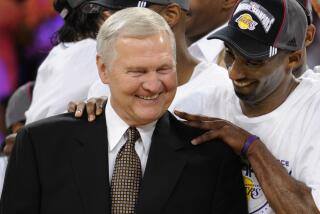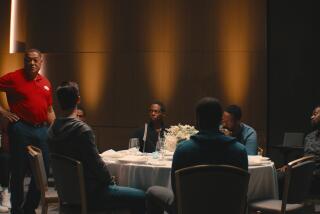Did Race Play a Role in Basketbrawl?
Was that a race war that erupted at the end of the Detroit Pistons-Indiana Pacers game last Friday night? White fans in the expensive seats throwing whatever they could get their hands on. Black players running into the stands, looking for the next white man to knock out?
As the intensity of this surreal episode starts to wear off and the inevitable spin cycle begins, people are rushing to find the cause and connect it to something larger. At first they didn’t discuss race, but now the conversation is right back where you’d expect it: Super-sized black men beating up helpless white men! Black men gone wild! Let’s blame hip-hop culture, the gangsta mentality, the rule of the street.
But in fact it is much more complicated than that. Race, basketball and the infusion of huge amounts of money -- all these factors have all become so intertwined that it’s hard to tell where one ends and the next begins.
Today, black players so define the NBA that it sounds redundant even to speak of a “black basketball player”; the blackness of the player is assumed in the occupation of basketball.
Fans, of course, are largely white. At least they are near the floor in the arena, where the fight broke out and where the expensive seats can run to hundreds or even thousands of dollars. Looking back on the video images from last Friday night certainly shows that to be the case.
But after that, the relationships get a little confused. The players are not only black, they are also wealthy -- a whole lot wealthier, for the most part, than the fans who come to watch them. And their wealth gives them a sense of freedom and independence that most Americans, regardless of race, will never experience.
But despite the millions of dollars the players make, if you’ve listened to them talking about the situation over the last few days, what you’ve heard is that they feel disrespected. They want respect, which is not something that has always been accorded to black men in this country. Though they are highly paid, the idea of “performing” for white audiences is not always something they’re comfortable with, considering U.S. racial history. In some previous eras, players might have been thought of as subservient, but now these individuals make so much money that the legacy of race is often confounded by the privileges of class.
Many of today’s wealthy NBA players have emerged from some of this nation’s poorest ‘hoods. Ron Artest, the player in the middle of all this, hails from the infamous Queensbridge projects in Queens, N.Y. Players like Artest often feel that they must “keep it real” in order to maintain their “street cred.” This means that even though Artest is a multimillionaire, he will still run after a fan for throwing a cup at him just to prove that his wealth has not made him soft. (When you consider the $5 million that Artest -- the Mike Tyson of the NBA -- will lose in salary during his suspension over the next year, it is pretty obvious that this was a situation when keeping it real went wrong.)
Fans see it all differently. Many believe that the price of their ticket entitles them to express their displeasure in any way they choose, however boorish, inappropriate or disrespectful that behavior might be. Take all this, mix it with some beer, and you get a serious conflict of identities between players and fans, and confusion about their respective roles. The result: Friday Night Fights, instead of a civil basketball game.
So was it a race war? Well, this is America, and race has something to do with practically everything. But that’s just the easy answer. What happened last Friday certainly wasn’t any kind of race war we’re familiar with. There are too many other factors: wealth, the culture of the players, the assumptions of the fans. The culture we live in today makes it more complicated than black versus white -- just as the whole issue of race is more complicated than black versus white, and it’s time we woke up to that.
More to Read
Go beyond the scoreboard
Get the latest on L.A.'s teams in the daily Sports Report newsletter.
You may occasionally receive promotional content from the Los Angeles Times.










